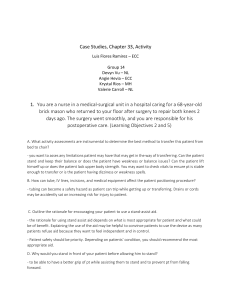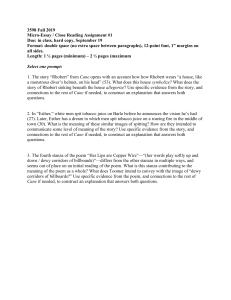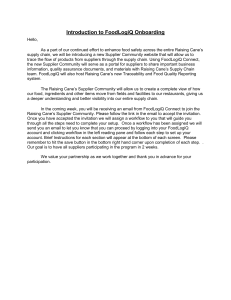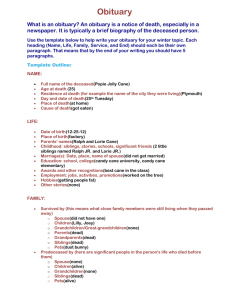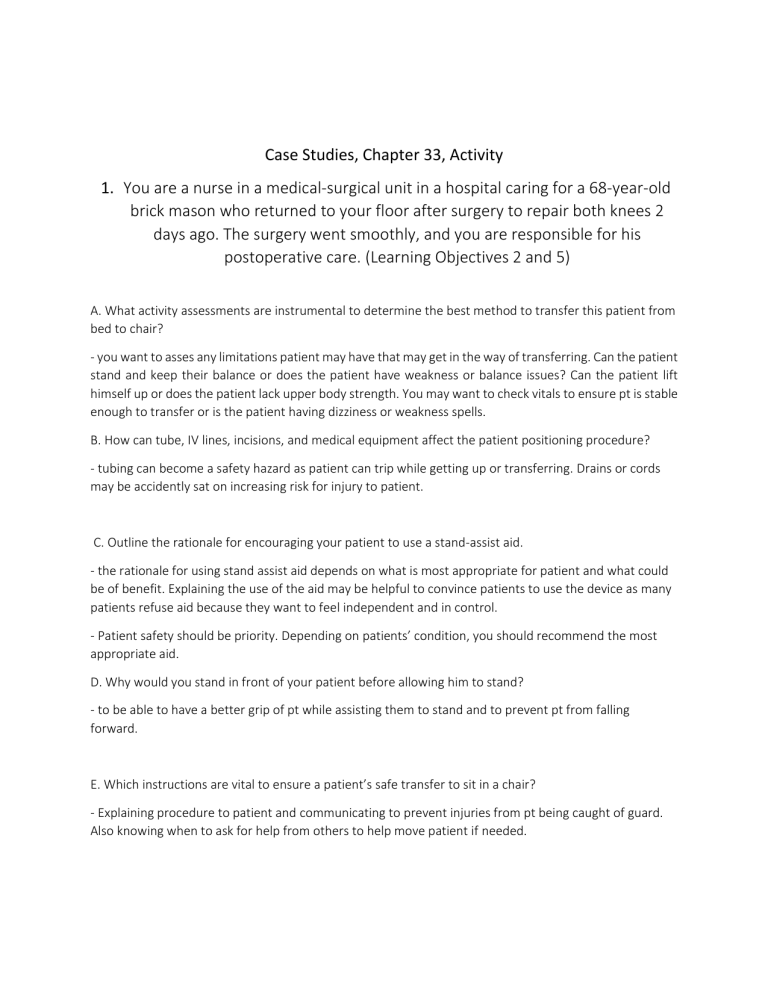
Case Studies, Chapter 33, Activity 1. You are a nurse in a medical-surgical unit in a hospital caring for a 68-year-old brick mason who returned to your floor after surgery to repair both knees 2 days ago. The surgery went smoothly, and you are responsible for his postoperative care. (Learning Objectives 2 and 5) A. What activity assessments are instrumental to determine the best method to transfer this patient from bed to chair? - you want to asses any limitations patient may have that may get in the way of transferring. Can the patient stand and keep their balance or does the patient have weakness or balance issues? Can the patient lift himself up or does the patient lack upper body strength. You may want to check vitals to ensure pt is stable enough to transfer or is the patient having dizziness or weakness spells. B. How can tube, IV lines, incisions, and medical equipment affect the patient positioning procedure? - tubing can become a safety hazard as patient can trip while getting up or transferring. Drains or cords may be accidently sat on increasing risk for injury to patient. C. Outline the rationale for encouraging your patient to use a stand-assist aid. - the rationale for using stand assist aid depends on what is most appropriate for patient and what could be of benefit. Explaining the use of the aid may be helpful to convince patients to use the device as many patients refuse aid because they want to feel independent and in control. - Patient safety should be priority. Depending on patients’ condition, you should recommend the most appropriate aid. D. Why would you stand in front of your patient before allowing him to stand? - to be able to have a better grip of pt while assisting them to stand and to prevent pt from falling forward. E. Which instructions are vital to ensure a patient’s safe transfer to sit in a chair? - Explaining procedure to patient and communicating to prevent injuries from pt being caught of guard. Also knowing when to ask for help from others to help move patient if needed. 2. As an orthopedic nurse, a significant proportion of your nursing care consists of assisting patients in ambulating, transferring, and practicing physical therapy treatments to restore their mobility. (Learning Objectives 7 and 8) A. What steps would you take to prevent personal injury when assisting patients to stand? Make sure you are using proper technique to prevent personal injury and to avoid any back injuries. - Make sure to ask for assistance if patient is too heavy for you to lift on your own and use the most appropriate aids if needed. B. How do these steps prevent/reduce injury? - They prevent injury by establishing safety is the main priority for both Nurse and Patient C. Describe techniques that, along with using a gait belt, prevent a patient from slipping when attempting to sit in a chair. - Things like nonslip socks can help and also assessing pts ability to sit and provide any support if needed. D. If your patient has hemiparesis, where would you stand to assist in ambulation? - You would assist patient by standing on the patient’s weaker side and slightly behind to prevent falls. E. Outline the correct initial use of a cane. - Make sure cane type is most appropriate depending on pts need ( single prong or quadcane), ensure cane is at proper height for pt to prevent injury. Ensure pt understands proper use of cane before attempting to use cane. - Cane should be held on pts stronger side; cane should move forward first at the same time as weaker leg and stronger leg follows.
